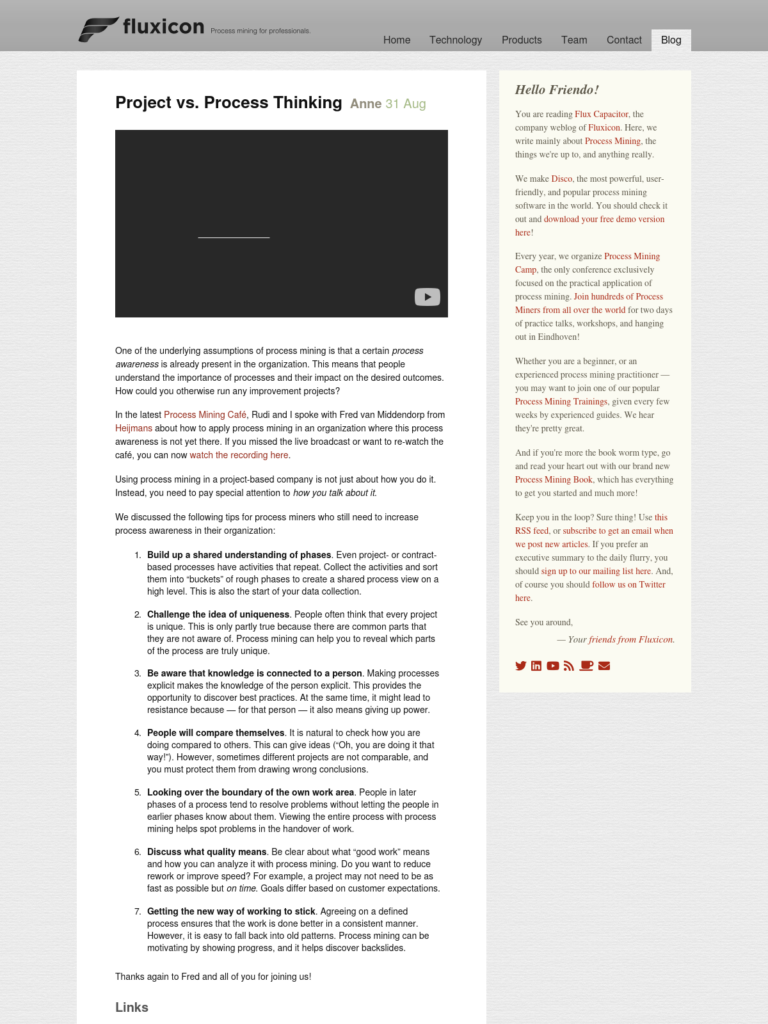Project vs. Process Thinking
One of the underlying assumptions of process mining is that a certain process awareness is already present in the organization. This means that people understand the importance of processes and their impact on the desired outcomes. How could you otherwise run any improvement projects?
In the latest Process Mining Café, Rudi and I spoke with Fred van Middendorp from Heijmans about how to apply process mining in an organization where this process awareness is not yet there. If you missed the live broadcast or want to re-watch the café, you can now watch the recording here.
Using process mining in a project-based company is not just about how you do it. Instead, you need to pay special attention to how you talk about it.
We discussed the following tips for process miners who still need to increase process awareness in their organization:
-
Build up a shared understanding of phases. Even project- or contract-based processes have activities that repeat. Collect the activities and sort them into “buckets” of rough phases to create a shared process view on a high level. This is also the start of your data collection.
-
Challenge the idea of uniqueness. People often think that every project is unique. This is only partly true because there are common parts that they are not aware of. Process mining can help you to reveal which parts of the process are truly unique.
-
Be aware that knowledge is connected to a person. Making processes explicit makes the knowledge of the person explicit. This provides the opportunity to discover best practices. At the same time, it might lead to resistance because — for that person — it also means giving up power.
-
People will compare themselves. It is natural to check how you are doing compared to others. This can give ideas (“Oh, you are doing it that way!”). However, sometimes different projects are not comparable, and you must protect them from drawing wrong conclusions.
-
Looking over the boundary of the own work area. People in later phases of a process tend to resolve problems without letting the people in earlier phases know about them. Viewing the entire process with process mining helps spot problems in the handover of work.
-
Discuss what quality means. Be clear about what “good work” means and how you can analyze it with process mining. Do you want to reduce rework or improve speed? For example, a project may not need to be as fast as possible but on time. Goals differ based on customer expectations.
-
Getting the new way of working to stick. Agreeing on a defined process ensures that the work is done better in a consistent manner. However, it is easy to fall back into old patterns. Process mining can be motivating by showing progress, and it helps discover backslides.
Thanks again to Fred and all of you for joining us!
Links
Here are the links that we mentioned during the session:
-
Process awareness is one dimension in the categorization of which processes are suitable for process mining
-
Keep in mind that the variants are not only determined by the “uniqueness” but also by the level of detail in your data. Abstracting to a higher level (for example, with the Milestone Method) will give you a process view with less variation and more common ground. See also this demo of simplification strategies in our customer journey café
-
Expect parallelism in your process map if you analyze project-based processes. Here are some strategies to simplify the parallel views if you are getting confused
Contact us via cafe@fluxicon.com if you have questions or suggestions for the café anytime.
Leave a Comment
You must be logged in to post a comment.








